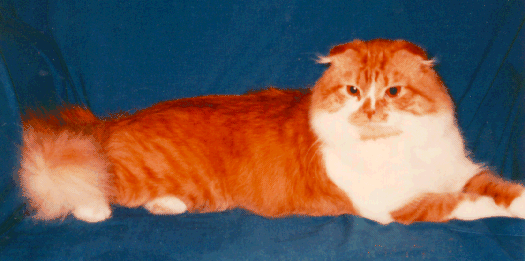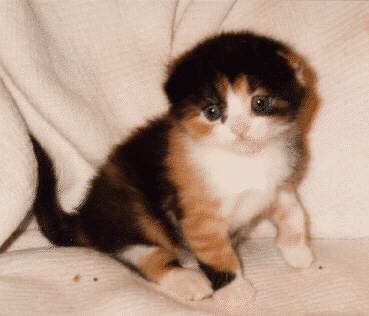Authors
Linnea Danielsen – Linanci Cattery, linancifolds@earthlink.net
Topics
- History
- Description
- Temperament
- Special Medical Concerns
- Is This Breed For Me?
- Frequently Asked Questions
History
Susie, the first Scottish Fold cat, was discovered in 1961 in the Tayside Region of Scotland, at a farm near Coupar Angus. She was a white barn cat with ears that folded downward and forward on her head. Her face resembled an “owl” or an “otter’s face”. A shepherd by the name of William Ross first noticed Susie’s unique ears at a neighbor’s barn. Since William and his wife Mary were Cat Fanciers they were fascinated with Susie. A year later Susie and a local tom had a litter of two folded ear kittens and the Ross’s acquired the female and named her Snooks. Snooks’ son was bred to a British Shorthair and so began the breed known today as the Scottish Fold. At this time the breed was registered with the Governing Council of the Cat Fancy in Great Britain.
In the mid 1960s, Pat Turner, a cat breeder and geneticist, became involved in the development of the Fold. Over the next 3 years she oversaw the breedings which produced 76 kittens – 42 with folded ears and 34 with straight ears. She and Peter Dyte, another British geneticist, agreed that the gene mutation responsible for folded ears is a simple dominant. This means that if a kitten inherits a gene from one parent for straight ears and one from a parent with the gene for folded ears, it will be a fold. They also learned that the original cats carried the longhair gene.
Susie, the original fold, was a loose fold which means the tips of her ears bent forward about halfway up the ear. This is now called a single fold. Today’s folds have ear folds ranging from the loose single fold to the very tight triple fold which is seen in the show quality cats.
A faction in the British Cat Fancy felt that the Scottish Fold would be prone to ear infections and deafness. They campaigned to prevent their acceptance for registry in Great Britain. Folds are still not accepted for registry in registries of Great Britain and Europe.
Mrs. Ross arranged for some of her folds to be shipped to Neil Todd, Ph.D., a geneticist in Newtonville, MA in the early 1970’s. The first American born litter arrived Nov. 30, 1971. After his study ended, some folded kittens were given to first one CFA affiliated breeder who gave some to another, etc., until the shorthair Scottish Folds were accepted by ACA for registration in 1973, ACFA and CFA in 1974. TICA was the first registry to recognized the longhairs for championship competition in the 1987-88 show season and CFA followed in 1993-94.
Although the Ross’ had to give up their efforts in their own country to develop and raise these adorable cats, they will always be regarded in America as the founders of the breed.
Description
After two decades of outcrossing to the American and British Shorthairs, the Scottish Fold has developed a look all its own. It is a medium sized cat, 9 to 13 pounds in the male and 6 to 9 pounds in the female. A Fold should have a well rounded, padded look to the entire body with a round headed appearance from all angles, domed at the top with a very short neck. The eyes should be large, round, broadly spaced and giving a sweet expression. A Fold can have straight medium-sized ears to small tightly folded ears with wide range in the degree of the fold. The ear tips will be rounded on the tip. A Fold will have well-rounded whisker pads with whiskers which often curve forward. The jaw is firm and well rounded. The nose is gently curved, short and wide due to the wide set of the eyes. Sometimes the curve of the mouth around their prominent whisker pads gives the appearance of a “smiling” cat. As you can see from the description, the Scottish Fold’s head should look round in all ways.
The Scottish Fold can be found in both the shorthair and longhaired version. The longhaired Scottish Fold has a semi-long coat of variable length which should sport a nice ruff on the males, leg britches and a huge fluffy tail.
Scottish Folds can be found in almost every color and combination of colors and white except for the pointed colors. This means that generally you will not be able to find a Scottish Fold who has the coloring of a Siamese or Himalayan. (The exception is Folds bred by members of the Cat Fanciers Federation, which allows the pointed pattern. All other registries consider pointed Folds to be AOV (Any Other Variety), and will not accept them for competition.) The brown tabby & white Scottish Fold is probably the most well known color but they can be found in everyone’s favorite colors.
Temperament
The Scottish Fold is a sweet natured cat who is usually quiet voiced and loves to help supervise whatever you happen to be doing. Their activity level is in the medium range. They love to play but usually expect you to be involved in the fun and games. While not every Fold will be a lap fungus, they will usually be found close to you. Scottish Folds love to sleep flat on their backs and can often be found sitting up looking very much like an otter.
Special Medical Concerns
In general the Scottish Fold is a healthy, hardy cat with a lifespan of approximately 15 yrs. Early in the development of this breed a degenerative joint disease was discovered to be linked with breeding folded-eared cats to folded-eared cats. Because of this, ethical breeders will only breed straight-eared cats to folded- eared cats. Scottish Folds who are the products of folded-ear to straight-ear breedings seldom if ever develop joint disease.
Affected Folds will usually show signs of the disease between the ages of 4 to 6 months. This disease, in its worst case, will cause the joints of the cat’s tail, ankles and knees to fuse and stiffen. A Scottish Fold with a very short thickened tail is probably affected to some extent. While this health problem is disabling, it is not life threatening. Though it cannot be cured, it can be very successfully treated.
Is This Breed For Me?
If you like a cat that is very active and for the most part aloof, then no, the Scottish Fold is not for you. If you want a cat who wants to know what you are doing and why you aren’t paying attention to him, then yes, you’d probably do well with a Scottish Fold. Scottish Folds want to be with you and will not do well if left alone for long periods of time. If you work long hours, you might want to consider getting your Scottish Fold a playmate from your local Humane Society or Shelter. Another option is in buying a pair of Folds – one folded-eared and one straight-eared. Two Folds will keep each other from getting lonely and will be twice the love and devotion when you are home.
Frequently Asked Questions
How do I find Scottish Fold breeders?
Scottish Folds are accepted in all the cat registry associations in the United States. Most of their central offices can give you names of breeders registered with them. Another option is to attend a cat show near you and talk to the breeders that are there. Get to know them and get on their waiting lists. Yes, a Waiting List!!! Because of the folded ear to straight ear breedings not all the kittens born have folded ears and for this reason most Fold breeders have waiting lists for their folded-eared kittens. Don’t feel like you are getting the run around if you aren’t able to find your special kitten for 6 or more months. (And if you want a specific color, sex, or coat length, you may have to wait even longer.)
Where else can I find information on the breed?
Another place to find information about Scottish Folds and breeders is to contact the International Scottish Fold Association. This is a CFA (Cat Fanciers Association) affiliated breed club. If you send a #10 SASE to ISFA, 12500 Skyline Dr., Burnsville, MN, 55337-2920, they will send you information on the breed itself and a list of member breeders. The Association is not only for breeders but is open to anyone with an interest in Scottish Folds and membership gets you a well written quarterly newsletter.
You can also purchase the paperback book titled Scottish Fold Cats: A Complete Owner’s Manual, written by Phil Maggitti. Any bookstore can order it for you. Most of the information is accurate though some of the genetics data is a little dated. It also has some wonderful color photos.
Is there more information on Scottish Folds on the Web?
Breeders of all breeds of cats, including Scottish Folds, may be found through the Fanciers breeder listing page.
Who is Linanci Cattery?
You can learn all about us and see some of our Scottish Folds at http://home.earthlink.net/~linancifolds.
Copyright © 1995-2004, Linnea Danielsen, linancifolds@earthlink.net. All Rights Reserved.
HTML by Laura Gilbreath
